Original | Odaily Planet Daily ( @OdailyChina )
Author | Dingdang ( @XiaMiPP )

On June 19, CEO and founder Humayun Sheikh announced the launch of a large-scale buyback plan: the Fetch Foundation will work with multiple exchanges and market makers to jointly promote a total of $50 million in FET token buybacks. Behind this is the underlying support brought by the continued growth in demand for its proxy platform and ASI-1 applications. FET is currently undervalued by the market, he said bluntly.
This repurchase plan is not an isolated case, but an increasingly obvious trend in the altcoin track in the past few months. Funds are flowing into BTC, and ETH has recently regained the favor of whales and institutions, but the altcoin market trading volume has dropped sharply, investor sentiment is weak, and project parties seem to have entered a collective survival hardship mode: in the context of financing difficulties and shrinking valuations, how to survive and how to tell a story that can still be believed has become a common issue facing every project.
Token repurchase is becoming the common answer for more and more projects.
Repurchase logic under the survival narrative
If the main theme of the bull market is growth story, then the bear market is about cash flow strength. Token repurchase is the natural extension of this logic: using the projects own funds to repurchase tokens in circulation, on the one hand, reduces market selling pressure and stabilizes the currency price; on the other hand, it is also a declaration to the outside world that we are still capable and confident.
In this process, repurchase is not just a market operation, but also a financial self-certification mechanism. Only when a project has sufficient income and reserves can it dare to take out real money to gamble on its future. For investors, this behavior itself is an endorsement of the projects value.
But because of this, only a small number of projects can truly continue to repurchase. Most projects can only put repurchase in governance proposals or roadmaps, and finally nothing happens. How the repurchase mechanism is designed, whether it is destroyed, and whether it is locked are important, but the core is always: do you have real, stable, and sustainable income?
Fetch.ai s buyback plan stems from the surge in the use of its ASI-1 and proxy platform. The platform value is rising, but the token price is stagnant. The $50 million in funds comes from the foundations reserves. This money may not be enough to rewrite the price curve of FET, but it is important that if the plan is implemented, it will break the markets inherent impression of the projects lack of cash flow.
Who is buying back?
After 2024, many established projects have started or even implemented repurchase plans. Although the repurchase methods are different, the motivation behind them is highly consistent: using cash flow to leverage confidence .
On April 9, 2025, the Aave buyback proposal was passed with 99.63% support. The full plan of the proposal is to buy back $1 million per week over the next 6 months, with the first buyback starting on April 10. Since the protocol fee buyback mechanism was enabled, Aave DAO has continued to implement a $1 million buyback plan per week. The latest data shows that the protocol has spent a total of $10 million to buy back 50,000 AAVEs, with an average cost price of $199.74. Based on the current market price of $264, this part of the treasury reserves has generated approximately $3 million in unrealized gains. This is not only a capital operation, but also reflects the execution and cash flow health of the Aave DAO governance structure. (Supplementary reading: Aave Economic Model Innovation: Anti-GHO Mechanism + Token Buyback Helps AAVE Soar 20% )
On the other hand, the 2 million USDS transferred to the repurchase address by Sky (formerly MakerDAO) and Rune have all been used to repurchase SKY. Since June 4, Rune has used 2.33 million USDS to repurchase 30.227 million SKY, accounting for about 1.4% of its circulation, and the average repurchase price is about 0.077 US dollars.
On February 14, Jupiter announced that 50% of all protocol fees would be used to repurchase JUP and locked for three years, and the repurchase officially started on February 17. So far, the JUP repurchase is worth about 25 million US dollars.
Hyperliquid started the repurchase on March 20, using 50%-100% of its platform revenue to repurchase HYPE tokens, most of which will be destroyed to reduce the circulation. According to the repurchase data, in the past 30 days, its repurchase amount reached about 55 million US dollars, with an average daily repurchase amount of 1.83 million US dollars. Based on this data, the quarterly repurchase can reach 165 million US dollars. According to the current price of HYPE at 37 US dollars, the repurchase amount is about 4.46 million, accounting for about 1.3% of its circulation (333 million).
According to TokenTerminal data, Skys annual revenue is about 310 million US dollars. In the stablecoin market, its annual revenue is only lower than Tether and Circle. Of course, in terms of revenue scale, there is still an unbridgeable gap between centralized stablecoins and decentralized stablecoins. Aaves revenue in the past year was about 100 million US dollars, ranking first in the lending market.

According to the data from defillama.com , Jupiters annualized revenue is around 30 million US dollars. It is worth noting that although Hyperliquid is an emerging DeFi project, its revenue in the past year has reached 320 million US dollars. With such a scale, its potential in the DeFi circle is very huge. For details, please read With a total transaction volume of 1.5 trillion US dollars, it tops the throne of on-chain contracts. Is Hyperliquid (HYPE) the next SOL?

Conclusion
Token repurchase is not a panacea, but it is indeed an effective narrative entry point in a cycle of scarce confidence. Instead of continuing to rely on empty vision, roadmap and empowerment, it is better to regain market attention with a solid revenue structure and clear financial actions.
The real competition is no longer how big a story you tell, but whether you can live to see the day it comes true.










